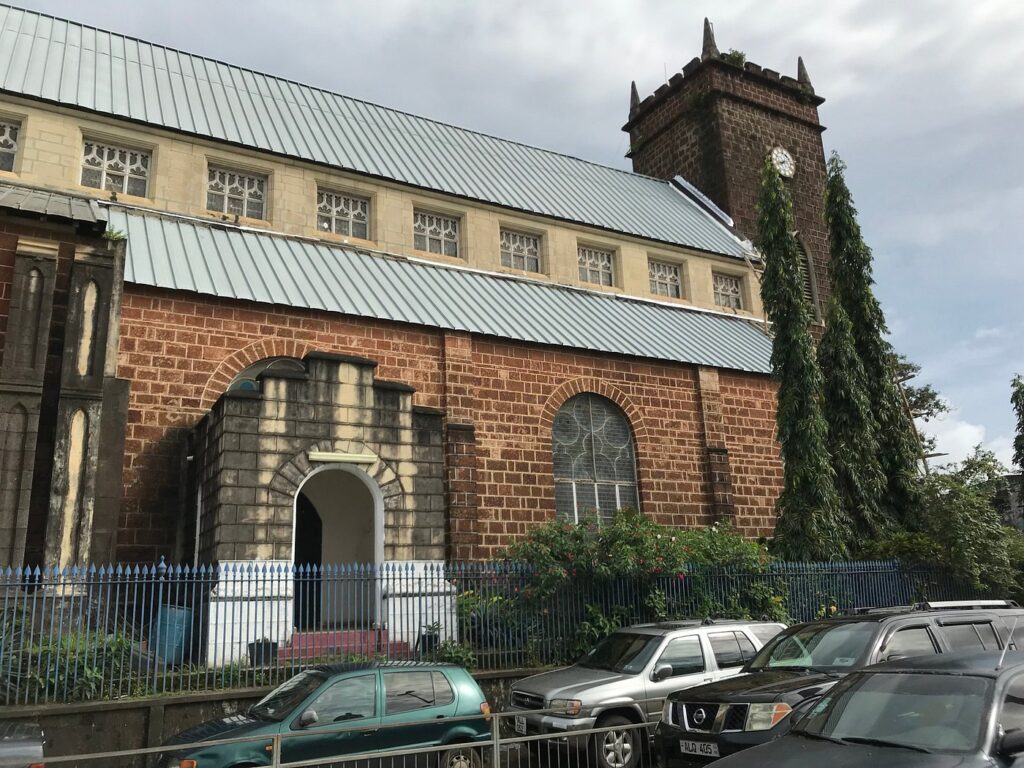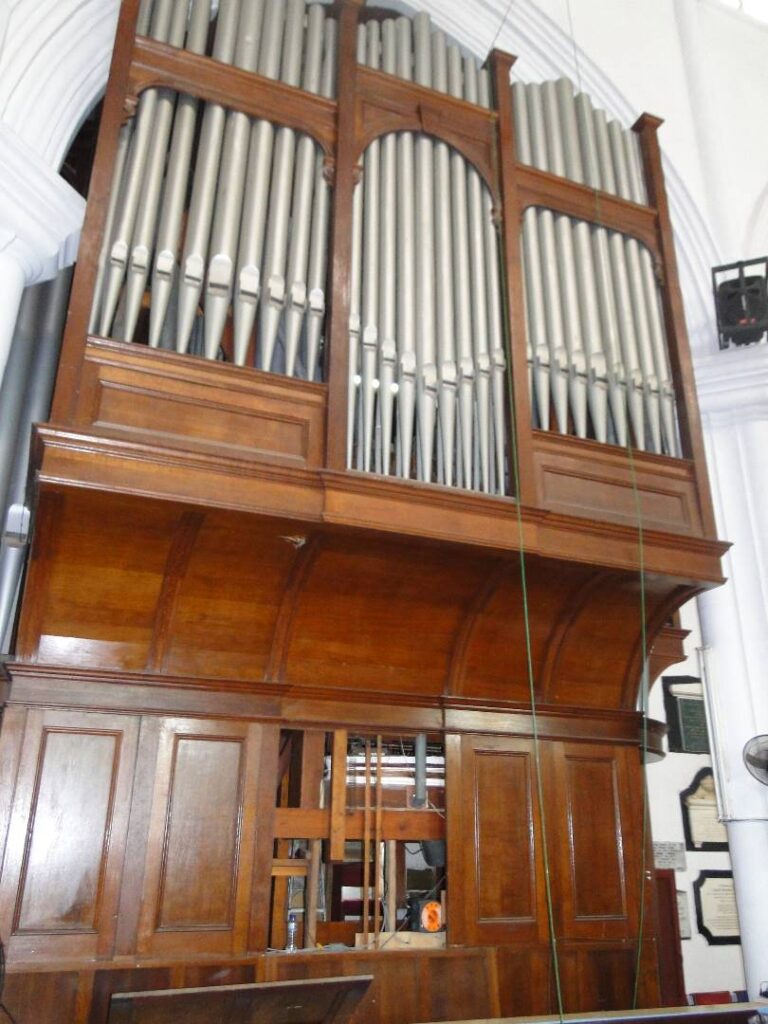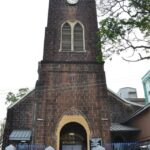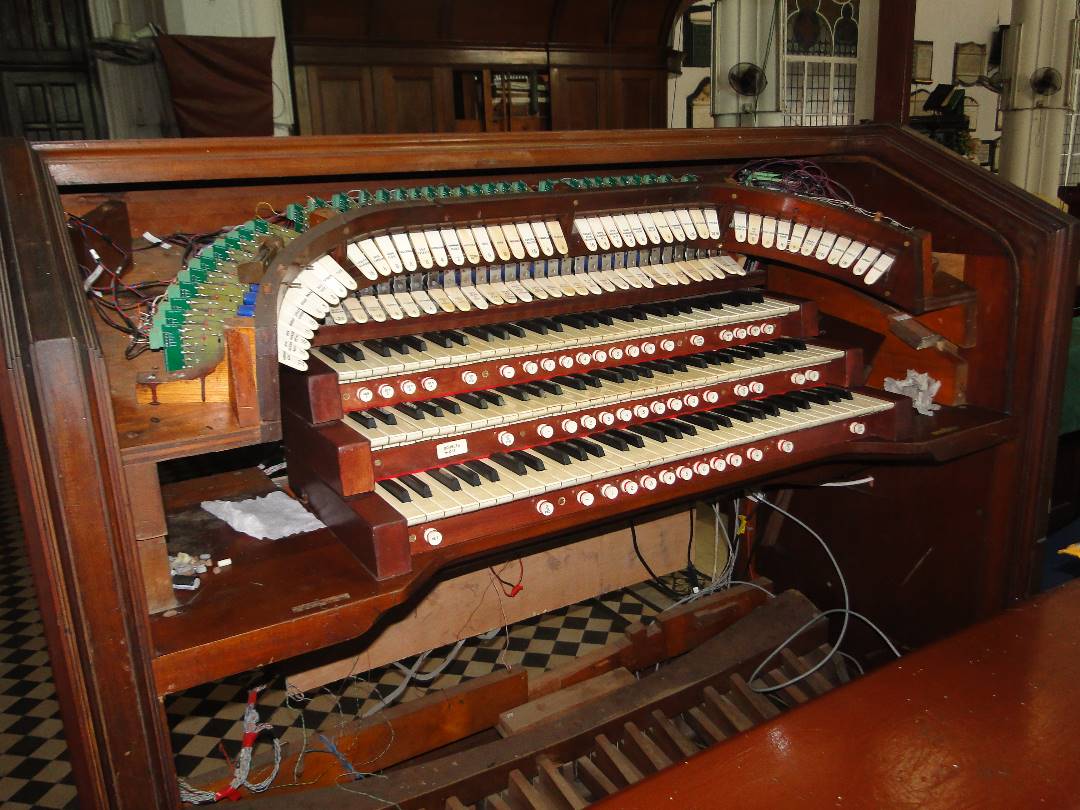
It’s been four years, since restoration work began on the mighty pipe organ in St George’s Cathedral, Freetown, Sierra Leone. Hundreds of parts have been dismantled, cleaned and painstakingly repaired. There are still a few steps to go before the instrument’s voice reverberates again throughout the cathedral, nevertheless it’s become clear that the result is going to be much more than originally anticipated.
According to restorer – Jonathan Lane and Tani Pratt, the Cathedral’s lead organist, St George’s pipe organ has the potential to be the best in West Africa, creating opportunities for the cathedral to be known region-wide for the quality of its music. Equally exciting is that the work is laying the foundations for a unique service restoring pipe organs across Africa.
The organ’s history
The organ came to St George’s in the late 90s, from the Shiloh Chapel, a Presbyterian Chapel in Aberystwyth, Wales and has an illustrious pedigree. It was built in 1934 by the prestigious London firm – Hill, Norman & Beard to the specification of the organist who was very well known in Wales. When the chapel was demolished in 1995 the instrument was dismantled and gifted to St George’s Cathedral.
The dismantled organ arrived in Sierra Leone in 1995 and after a slow start, contact was made with the UK company – Jardines Church Organs who came to Sierra Leone to finish the installation in association with W&O Pipe Organs – a Sierra Leonean organ repair business from times past.
Sixty years of use, followed by dismantling, storage, shipping and reinstallation took its toll on the instrument, causing some of the more fragile parts to wear more rapidly than would have been the case if the organ had remained in the Shiloh Chapel, explains Jonathan Lane. “And because most of the people who were part of the original installation are no longer around, there is lots about that period that we don’t know,” he continues.
A valuable asset
The organ now requires major repair work. Although this will cost in the region of $140,000, once fully restored it will be worth about $1 million.
This makes it an asset worth preserving by any stretch of the imagination, says Tani Pratt. “A well-maintained pipe organ can last well over 200 years and appreciate in monetary value as it ages, whereas an electronic replacement would last a maximum of 30 years. In Sierra Leone, the added complications of the climate and erratic electricity would reduce that to nearer 20 years,” he continues.
It is said that an organ by a good maker is a work of art and as a musician, Tani Pratt agrees, saying that the real value of an expertly built and well-maintained pipe organ is in the quality of its sound. “The architecture of a cathedral and the design of a pipe organ are created for each other, so as to maximise their height, area, and air passage,” he explains. “For sacred church and choral music and also organ recitals, the pipe organ is far superior to an electronic organ. It has a beautiful round melodious quality and when played by an experienced organist becomes at one with the choir.
“In the United States of America where the Pipe Industry has entered the 21st century as a vibrant, active, and busy industry, industry sales total close to $70 million annually,” he adds.
An unusual and challenging project
Although Jonathan Lane is an experienced organist and organ builder, who has made restoring these complex musical instruments his life’s work, the St George’s pipe organ is proving to be one of his most unusual and challenging jobs to date.
“A restoration of this nature would typically take three men a year to complete,” he explains. “We would dismantle the instrument, transport it to our workshop, where we have all the necessary tools and machines. We would then return with the finished product to install it.”
Instead, this job has been conducted entirely on site, with Lane flying between France, where he is based and Sierra Leone. Obviously COVID-19 was a huge impediment to progress because it prevented Lane from travelling, but even when he’s in Sierra Leone, church services, weddings, funerals, power cuts and the time it takes to source parts and tools in country cause considerable delays.
The budget is only part of the reason that the job is being done on site. Before the organ was properly examined, the hope was that the minor repairs minor be sufficient. Instead, there has been a process of cause and effect, with one repair highlighting hitherto hidden problems, unsurprising considering that an organ has 25,000 individual parts.
Training young Sierra Leoneans in the art and science of restoration
But equally important is that, carrying out the repairs on site allows two young Sierra Leoneans – Christopher James and Maurice Williams – to be trained in the craft of restoration – an opportunity they would never otherwise have had. “Education and sustainability are an important part of this process. We are cutting down on cost of fixing long term, which is also why it’s important to do the restoration properly now, so it will be 50 years before it will have to done again,” says Lane.
Recently James and Williams learned to re-leather the bellows (the parts that push air into that wind chest, which in turn lets air into the pipes when the keys are pressed.). “They did the first few under my direction. I was able to leave them to do the same for the eight others,” Lane adds.
To facilitate the on-site work, a set of essential tools, which includes wood working tools and specialist organ builder tools, was assembled, and sent out to Sierra Leone before the job started. Other necessary tools were sourced in Sierra Leone. These are supplemented with Lane’s own set of specialist tools which he always travels with. “
“The first thing we did four years ago was to replace the blower because it wasn’t producing enough wind. When we started dismantling it, we found loads of muck had been sucked in that had damaged the system. Once we fitted the blower, and air started flowing through the system, we started to discover other things. Air was leaking from the system because joints and leather had failed. That is when we started repair work on the bellows,” Lane continues.
Creating an income stream
They are just one or two steps from being able to play the organ again, says Lane, and he hopes to make this happen on his next trip to Sierra Leone. This will create many more possibilities – concerts, musical evenings, teaching workshops – events that will attract people from across the region and contribute to the musical and financial success of the church.
And with a cohort of people with the necessary skills, a pipe organ restoration company is also on the horizon. There are six pipe organs across Sierra Leone, that Lane has been asked to look it. In Ghana – the organ in the cathedral is currently the only one working. There are also pipe organs in Liberia and Cote d’Ivoire that require work.

For the love of music
Tani Pratt comes from a family with music embedded in its DNA. As far back as he can remember, his family has been known for playing the pipe organ in churches around Sierra. Leone including Gibraltar Church, Ebenezer Methodist Church, Buxton Memorial Methodist Church and Bo Methodist Church.
His own musical journey has carried him into churches and connected him with communities across the world. Freetown, Cambridge, London, Koidu and Zimbabwe are just a few of the places, where he has practised his music and developed his skills.
As an engineer and a musician, he believes that the value of incorporating music into all facets of society cannot be overstated. It can help break down walls and boundaries, aid reconciliation and education. Around the world, music is used as a vehicle for social change and bringing communities together.
And while there are as many musical instruments as there are cultures, pipe organs are arguably the ultimate convergence of art, science, craft and technology, which makes it all the more important that we recognise the incredible asset that is St George’s pipe organ and the benefits it can bring to our society as a whole.
As Pope Benedict XVI said: “The organ has always been considered, and rightly so, the king of musical instruments, because it takes up all the sounds of creation and gives resonance to the fullness of human sentiments, from joy to sadness, from praise to lamentation. By transcending the merely human sphere, as all music of quality does, it evokes the divine.”









